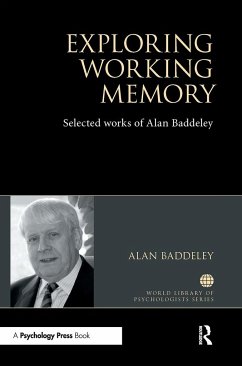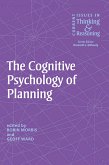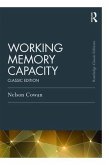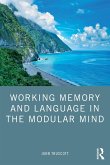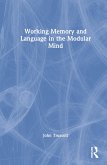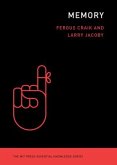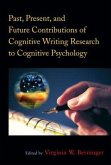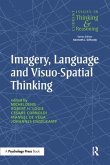- Broschiertes Buch
- Merkliste
- Auf die Merkliste
- Bewerten Bewerten
- Teilen
- Produkt teilen
- Produkterinnerung
- Produkterinnerung
In the World Library of Psychologists series, international experts present career-long collections of what they judge to be their finest pieces - extracts from books, key articles, salient research findings, and their major practical theoretical contributions. Alan Baddeley has an international reputation as an eminent scholar and pioneer in th
Andere Kunden interessierten sich auch für
![The Cognitive Psychology of Planning The Cognitive Psychology of Planning]() The Cognitive Psychology of Planning58,99 €
The Cognitive Psychology of Planning58,99 €![Working Memory Capacity Working Memory Capacity]() Nelson CowanWorking Memory Capacity47,99 €
Nelson CowanWorking Memory Capacity47,99 €![Working Memory and Language in the Modular Mind Working Memory and Language in the Modular Mind]() John TruscottWorking Memory and Language in the Modular Mind40,99 €
John TruscottWorking Memory and Language in the Modular Mind40,99 €![Working Memory and Language in the Modular Mind Working Memory and Language in the Modular Mind]() John TruscottWorking Memory and Language in the Modular Mind152,99 €
John TruscottWorking Memory and Language in the Modular Mind152,99 €![Memory Memory]() Fergus CraikMemory11,99 €
Fergus CraikMemory11,99 €![Past, Present, and Future Contributions of Cognitive Writing Research to Cognitive Psychology Past, Present, and Future Contributions of Cognitive Writing Research to Cognitive Psychology]() Past, Present, and Future Contributions of Cognitive Writing Research to Cognitive Psychology201,99 €
Past, Present, and Future Contributions of Cognitive Writing Research to Cognitive Psychology201,99 €![Imagery, Language and Visuo-Spatial Thinking Imagery, Language and Visuo-Spatial Thinking]() Imagery, Language and Visuo-Spatial Thinking55,99 €
Imagery, Language and Visuo-Spatial Thinking55,99 €-
-
-
In the World Library of Psychologists series, international experts present career-long collections of what they judge to be their finest pieces - extracts from books, key articles, salient research findings, and their major practical theoretical contributions. Alan Baddeley has an international reputation as an eminent scholar and pioneer in th
Hinweis: Dieser Artikel kann nur an eine deutsche Lieferadresse ausgeliefert werden.
Hinweis: Dieser Artikel kann nur an eine deutsche Lieferadresse ausgeliefert werden.
Produktdetails
- Produktdetails
- World Library of Psychologists
- Verlag: Taylor & Francis Ltd
- Seitenzahl: 394
- Erscheinungstermin: 18. Dezember 2020
- Englisch
- Abmessung: 234mm x 156mm x 21mm
- Gewicht: 610g
- ISBN-13: 9780367735784
- ISBN-10: 0367735784
- Artikelnr.: 68435783
- Herstellerkennzeichnung
- Libri GmbH
- Europaallee 1
- 36244 Bad Hersfeld
- gpsr@libri.de
- World Library of Psychologists
- Verlag: Taylor & Francis Ltd
- Seitenzahl: 394
- Erscheinungstermin: 18. Dezember 2020
- Englisch
- Abmessung: 234mm x 156mm x 21mm
- Gewicht: 610g
- ISBN-13: 9780367735784
- ISBN-10: 0367735784
- Artikelnr.: 68435783
- Herstellerkennzeichnung
- Libri GmbH
- Europaallee 1
- 36244 Bad Hersfeld
- gpsr@libri.de
Alan Baddeley is Professor of Psychology at the University of York and one of the world's leading authorities on Human Memory. He is celebrated for devising the ground-breaking and highly influential working memory model with Graham Hitch in the early 1970s, a model which still proves valuable today in recognising the functions of short-term memory. He was awarded a CBE for his contributions to the study of memory, is a Fellow of the Royal Society, the British Academy, the Academy of Medical Sciences, and the American Academy of Arts and Sciences. In 2012 he received the BPS Research Board's Lifetime Achievement Award and in 2016 the International Union of Psychological Sciences Award for Major Advancement in Psychological Science.
Permissions acknowledgements
Introduction
PART 1 How many kinds of memory?
1. Short-term memory for word sequences as a function of acoustic
semantic and formal similarity (Baddeley
1966)
2.Simultaneous acoustic and semantic coding in short-term memory (Baddeley & Ecob
1970)
3. Amnesia and the distinction between long- and short-term memory (Baddeley & Warrington
1970) PART 2 A multicomponent model 4. Working memory (Baddeley & Hitch
1974)
5. The recency effect: implicit learning with explicit retrieval? (Baddeley & Hitch
1993)
6. The concept of working memory: a view of its current state and probable future development (Baddeley
1981) PART 3 The phonological loop 7. Word length and the structure of short-term memory (Baddeley
Thomson & Buchanan
1975)
8. Exploring the articulatory loop (Baddeley
Lewis & Vallar
1984)
9. When long-term learning depends on short-term storage (Baddeley
Papagno & Vallar
1988)
10. The phonological loop as a language learning device (Baddeley
Gathercole & Papagno
1998) PART 4 The visuo-spatial sketchpad 11. Reaction time and short-term visual memory (Phillips & Baddeley
1971)
12. Spatial working memory (Baddeley & Lieberman
1980)
13. Interference with visual short-term memory (Logie
Zucco & Baddeley
1990)
PART 5 The central executive
14. The central executive: a concept and some misconceptions (Baddeley
1998)
15. Exploring the central executive (Baddeley
1996)
16. Dementia and working memory (Baddeley
Logie
Bressi
Della Sala & Spinnler
1986)
PART 6 The episodic buffer 17. The episodic buffer: a new component of working memory? (Baddeley
2000)
18. Binding in visual working memory: The role of the episodic buffer (Baddeley
Allen & Hitch
2011)
19. Working memory: theories
models
and controversies (Baddeley
2012)
Introduction
PART 1 How many kinds of memory?
1. Short-term memory for word sequences as a function of acoustic
semantic and formal similarity (Baddeley
1966)
2.Simultaneous acoustic and semantic coding in short-term memory (Baddeley & Ecob
1970)
3. Amnesia and the distinction between long- and short-term memory (Baddeley & Warrington
1970) PART 2 A multicomponent model 4. Working memory (Baddeley & Hitch
1974)
5. The recency effect: implicit learning with explicit retrieval? (Baddeley & Hitch
1993)
6. The concept of working memory: a view of its current state and probable future development (Baddeley
1981) PART 3 The phonological loop 7. Word length and the structure of short-term memory (Baddeley
Thomson & Buchanan
1975)
8. Exploring the articulatory loop (Baddeley
Lewis & Vallar
1984)
9. When long-term learning depends on short-term storage (Baddeley
Papagno & Vallar
1988)
10. The phonological loop as a language learning device (Baddeley
Gathercole & Papagno
1998) PART 4 The visuo-spatial sketchpad 11. Reaction time and short-term visual memory (Phillips & Baddeley
1971)
12. Spatial working memory (Baddeley & Lieberman
1980)
13. Interference with visual short-term memory (Logie
Zucco & Baddeley
1990)
PART 5 The central executive
14. The central executive: a concept and some misconceptions (Baddeley
1998)
15. Exploring the central executive (Baddeley
1996)
16. Dementia and working memory (Baddeley
Logie
Bressi
Della Sala & Spinnler
1986)
PART 6 The episodic buffer 17. The episodic buffer: a new component of working memory? (Baddeley
2000)
18. Binding in visual working memory: The role of the episodic buffer (Baddeley
Allen & Hitch
2011)
19. Working memory: theories
models
and controversies (Baddeley
2012)
Permissions acknowledgements
Introduction
PART 1 How many kinds of memory?
1. Short-term memory for word sequences as a function of acoustic
semantic and formal similarity (Baddeley
1966)
2.Simultaneous acoustic and semantic coding in short-term memory (Baddeley & Ecob
1970)
3. Amnesia and the distinction between long- and short-term memory (Baddeley & Warrington
1970) PART 2 A multicomponent model 4. Working memory (Baddeley & Hitch
1974)
5. The recency effect: implicit learning with explicit retrieval? (Baddeley & Hitch
1993)
6. The concept of working memory: a view of its current state and probable future development (Baddeley
1981) PART 3 The phonological loop 7. Word length and the structure of short-term memory (Baddeley
Thomson & Buchanan
1975)
8. Exploring the articulatory loop (Baddeley
Lewis & Vallar
1984)
9. When long-term learning depends on short-term storage (Baddeley
Papagno & Vallar
1988)
10. The phonological loop as a language learning device (Baddeley
Gathercole & Papagno
1998) PART 4 The visuo-spatial sketchpad 11. Reaction time and short-term visual memory (Phillips & Baddeley
1971)
12. Spatial working memory (Baddeley & Lieberman
1980)
13. Interference with visual short-term memory (Logie
Zucco & Baddeley
1990)
PART 5 The central executive
14. The central executive: a concept and some misconceptions (Baddeley
1998)
15. Exploring the central executive (Baddeley
1996)
16. Dementia and working memory (Baddeley
Logie
Bressi
Della Sala & Spinnler
1986)
PART 6 The episodic buffer 17. The episodic buffer: a new component of working memory? (Baddeley
2000)
18. Binding in visual working memory: The role of the episodic buffer (Baddeley
Allen & Hitch
2011)
19. Working memory: theories
models
and controversies (Baddeley
2012)
Introduction
PART 1 How many kinds of memory?
1. Short-term memory for word sequences as a function of acoustic
semantic and formal similarity (Baddeley
1966)
2.Simultaneous acoustic and semantic coding in short-term memory (Baddeley & Ecob
1970)
3. Amnesia and the distinction between long- and short-term memory (Baddeley & Warrington
1970) PART 2 A multicomponent model 4. Working memory (Baddeley & Hitch
1974)
5. The recency effect: implicit learning with explicit retrieval? (Baddeley & Hitch
1993)
6. The concept of working memory: a view of its current state and probable future development (Baddeley
1981) PART 3 The phonological loop 7. Word length and the structure of short-term memory (Baddeley
Thomson & Buchanan
1975)
8. Exploring the articulatory loop (Baddeley
Lewis & Vallar
1984)
9. When long-term learning depends on short-term storage (Baddeley
Papagno & Vallar
1988)
10. The phonological loop as a language learning device (Baddeley
Gathercole & Papagno
1998) PART 4 The visuo-spatial sketchpad 11. Reaction time and short-term visual memory (Phillips & Baddeley
1971)
12. Spatial working memory (Baddeley & Lieberman
1980)
13. Interference with visual short-term memory (Logie
Zucco & Baddeley
1990)
PART 5 The central executive
14. The central executive: a concept and some misconceptions (Baddeley
1998)
15. Exploring the central executive (Baddeley
1996)
16. Dementia and working memory (Baddeley
Logie
Bressi
Della Sala & Spinnler
1986)
PART 6 The episodic buffer 17. The episodic buffer: a new component of working memory? (Baddeley
2000)
18. Binding in visual working memory: The role of the episodic buffer (Baddeley
Allen & Hitch
2011)
19. Working memory: theories
models
and controversies (Baddeley
2012)

